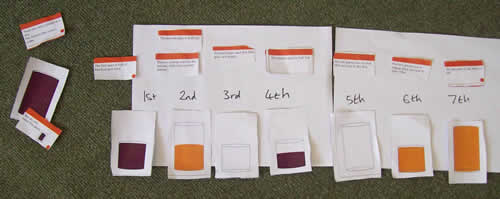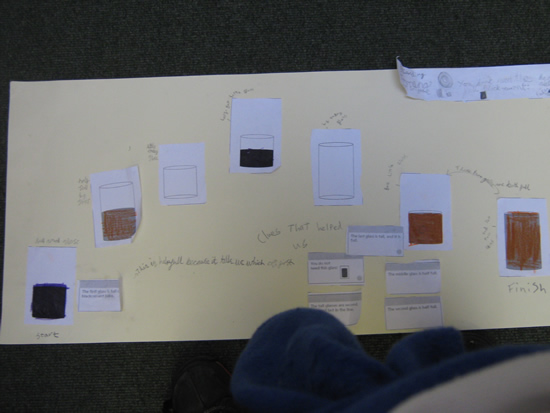Or search by topic
Number and algebra
Geometry and measure
Probability and statistics
Working mathematically
Advanced mathematics
For younger learners
Thirsty?



- Problem
- Getting Started
- Student Solutions
- Teachers' Resources
Class 2C at Manor School in Didcot wrote to us:
2C decided to work in groups of three and four. One person cut out the pictures, one person read the clues and the other person moved them around. We got a bit confused, and some children had the idea of labelling the places for the cups 1st, 2nd, 3rd, 4th, 5th, 6th and 7th. This helped us a lot as we could look at one place at a time. One group started laying the clues down next to the place they talked about, and this helped us make sure we had read them all.In the end our teacher read all the clues out and we checked that our order fitted every clue.

I like the way you could check yourselves whether your solution was correct.
Class 3 at Levens C of E School also sent us a photo of their final solution. They said:
We started with this clue: 'The first glass is full of blackcurrant juice.'
Well done - you're right this clue does help, doesn't it? But perhaps it only helps if you've already read the one which told you that you need to leave out the tall glass full of blackcurrant juice!
Class 3 sent this picture of their solution:

Thank you also to Owen, Jack, Mollie and Emily from Church Broughton and Lewis from Castledyke Primary for your solutions.
You may also like
It's a Fence!
In this challenge, you will work in a group to investigate circular fences enclosing trees that are planted in square or triangular arrangements.
Sorting the Numbers
Complete these two jigsaws then put one on top of the other. What happens when you add the 'touching' numbers? What happens when you change the position of the jigsaws?
Getting Better at Group Work Lower Primary
Three or four brains are usually better than one! Working on a problem in a group rather than on your own is often a good idea. These activities will help you get better at group work.

